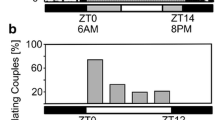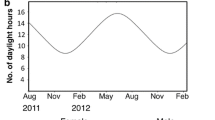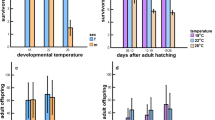Abstract
Successful management of invasive pests, such as Drosophila suzukii, relies on a fine understanding of their biology. Genomic and physiological studies have suggested that the invasive success of D. suzukii is strongly associated with its ability to overwinter in a reproductive diapause state. Here, we coupled field surveys with comparative morphology and genetics to increase our understanding of D. suzukii overwintering behavior and provide useful indications for its management. The results of a 4-year-long field trapping in an Italian mountain region indicate that D. suzukii is continuously captured during winter months and that the number of captures is correlated with temperature. Capture patterns are also contrasting between sexes: while females are more abundantly caught during winter and summer, males are more abundant in spring and autumn. We found that overwintering could occur not only in natural environments, such as woods, but also in anthropic shelters. Comparative morphology and genetics further indicate that spermathecae may play an important adaptive role during winter. Our results unveil complex winter biology in D. suzukii and highlight how the number of overwintering females is an earlier predictor of summer population size. We hence propose that in a given year infestation may be better forecasted by taking into account the captures of the previous winter. We recommend that control methods be diapause-aware. For instance, they should take place in late winter/early spring and close to natural environments, and not only in fruit ripening season and close to orchards.





Similar content being viewed by others
References
Asplen MK, Anfora G, Biondi A, Choi DS, Chu D, Daane KM, Gibert P, Gutierrez AP, Hoelmer KA, Hutchison WD, Isaacs R, Jiang ZL, Kárpáti Z, Kimura MT, Pascual M, Philips CR, Plantamp C, Ponti L, Vétek G, Vogt H, Walton VM, Yu Y, Zappalà L, Desneux N (2015) Invasion biology of Spotted Wing Drosophila (Drosophila suzukii): a global perspective and future priorities. J Pest Sci 88:469–494
Ayrinhac A, Debat V, Gibert P, Kister AG, Legout H, Moreteau B, Vergilino R, David JR (2004) Cold adaptation in geographical populations of Drosophila melanogaster: phenotypic plasticity is more important than genetic variability. Funct Ecol 18:700–706
Briem F, Eben A, Gross J, Vogt H (2016) An invader supported by a parasite: mistletoe berries as a host for food and reproduction of Spotted Wing Drosophila in early spring. J Pest Sci. doi:10.1007/s10340-016-0739-6
Cattel J, Kaur R, Gibert P, Martinez J, Fraimout A, Jiggins F et al (2016) Wolbachia in European populations of the invasive pest Drosophila suzukii: regional variation in infection frequencies. PLoS One 11(1):e0147766. doi:10.1371/journal.pone.0147766
Cha D, Adams T, Rogg H, Landolt PJ (2012) Identification and field evaluation of fermentation volatiles from wine and vinegar that mediate attraction of spotted wing Drosophila, Drosophila suzukii. J Chem Ecol 38:1419–1431
Cha DH, Hesler SP, Cowles RS, Vogt H, Loeb GM, Landolt PJ (2013) Comparison of a synthetic chemical lure and standard fermented baits for trapping Drosophila suzukii (Diptera: Drosophilidae). Environ Entomol 42:1052–1060
Cha DH, Adams T, Werle CT, Sampson BJ, Adamczyk JJ Jr, Rogg H, Landolt PJ (2014) A four-component synthetic attractant for Drosophila suzukii (Diptera: Drosophilidae) isolated from fermented bait headspace. Pest Manag Sci 70:324–331
Chapman RF (1998) The insects; structure and function, 4th edn. Cambridge University Press, Cambridge, p 403. ISBN 0-521-57048-4
Cini A, Ioriatti C, Anfora G (2012) A review of the invasion of Drosophila suzukii in Europe and a draft research agenda for integrated pest management. Bull Insectol 65(1):149–160
Cini A, Anfora G, Escudero-Colomar LA, Grassi A, Santosuosso U, Seljak G, Papini A (2014) Tracking the invasion of the alien fruit pest Drosophila suzukii in Europe. J Pest Sci 87:559–566
Dalton DT, Walton VM, Shearer PW, Walsh DB, Caprile J, Isaacs R (2011) Laboratory survival of Drosophila suzukii under simulated winter conditions of the Pacific Northwest and seasonal field trapping in five primary regions of small and stone fruit production in the United States. Pest Manag Sci 67(11):1368–1374
De Ros G, Conci S, Pantezzi T, Savini G (2015) The economic impact of invasive pest Drosophila suzukii on berry production in the Province of Trento, Italy. J Berry Res 5(2):89–96
Dekker T, Mansourian S, Revadi S, Lebreton S, Becher P, Angeli S, Rota-Stabelli O, Anfora G (2015) From pheromone to antagonist: cis-vaccenyl acetate loss in Drosophila suzukii reverses its role in sexual communication. Proc R Soc B 282:20143018
Denlinger DL (2002) Regulation of diapause. Annu Rev Entomol 47:93–122
Denlinger DL (2008) Why study diapause? Entomol Res 38:1–9
Deprà M, Poppe JL, Schmitz HJ, De Toni DC, Valente VLS (2014) The first records of the invasive pest Drosophila suzukii in the South American continent. J Pest Sci 87:379–383
Gibert JM, Peronnet F, Schlotterer C (2007) Phenotypic plasticity in Drosophila pigmentation caused by temperature sensitivity of a chromatin regulator network. PLoS Genet 3:266–280
Grassi A, Anfora G, Maistri S, Maddalena G, De Cristofaro A, Savini G, Ioriatti C (2015) Development and efficacy of Droskidrink, a food bait for trapping Drosophila suzukii. IOBC Bull 109:197–204
Hamby KA, Kwok RS, Zalom FG, Chiu JC (2013) Integrating circadian activity and gene expression profiles to predict chronotoxicity of Drosophila suzukii response to insecticides. PLoS One 8(7):e68472
Hamby KA, Bolda MP, Sheehan ME, Zalom FG (2014) Seasonal monitoring for Drosophila suzukii (Diptera: Drosophilidae) in California commercial raspberries. Environ Entomol 43(4):1008–1018
Harris DW, Hamby KA, Wilson HE, Zalom FG (2014) Seasonal monitoring od Drosophila suzukii (Diptera: Drosophilidae) in a mixed fruit production system. J Asia Pac Entomol 17:857–864
Hodek I, Iperti G (1983) Sensitivity to photoperiod in relation to diapause in Semiadalia undecimnotata females. Entomol Exp Appl 34(1):9–12
Jakobs R, Gariepy TD, Sinclair BJ (2015) Adult plasticity of cold tolerance in a continental-temperate population of Drosophila suzukii. J Insect Physiol 79:1–9
Kanzawa T (1939) Studies on Drosophila suzukii Mats. Yamanashi Agricultural Experimental Station, Kofu, pp 1–49
Kimura MT (1988) Adaptation to temperate climates and evolution of over-wintering strategies in the Drosophila melanogaster species group. Evolution 42:1288–1297
Kimura MT (2004) Cold and heat tolerance of drosophilid flies with reference to their latitudinal distributions. Oecologia 140:442–449
Kleiber JR, Unelius CR, Lee JC, Suckling DM, Qian MC, Bruck DJ (2014) Attractiveness of fermentation and related products to spotted wing drosophila (Diptera: Drosophilidae). Environ Entomol 43(2):439–447
Knipling EF (1959) Sterile-male method of population control. Science 130:902–904
Kvam E, Dahle J (2003) Pigmented melanocytes are protected against ultraviolet-A-induced membrane damage. J Investig Dermatol 121:564–569
Landolt PJ, Adams T, Rogg H (2012) Trapping spotted wing drosophila, Drosophila suzukii (Matsumura), with combinations of vinegar and wine, and acetic acid and ethanol. J Appl Entomol 136:148–154
Laven H (1967) Eradication of Culex pipiens fatigans through cytoplasmic incompatibility. Nature 216:383–384
Li J, Zhao M, He P, Hidalgo M, Baker SD (2007) Differential metabolism of gefitinib and erlotinib by human cytochrome P450 enzymes. Clin Cancer Res 13:3731–3737
Malta J, Martins GF, Marques AE, Games PD, Zanuncio JC, Baracat-Pereira MC, Fernandes Salomão TM et al (2014) Insights into the proteome of the Spermatheca of the leaf-cutting ant Atta sexdens rubropilosa (Hymenoptera: Formicidae). Fla Entomol 97(4):1856–1861
Mitsui H, Beppu K, Kimura MT (2010) Seasonal life cycles and resource uses of flower and fruit-feeding drosophilid flies (Diptera: Drosophilidae) in central Japan. Entomol Sci 13:60–67
Neubaum DM, Wolfner MF (1999) Wise, winsome or weird: mechanisms of sperm storage in female animals. Curr Top Dev Biol 41:67–97
Nyamukondiwa C, Terblanche JS, Marshall KE, Sinclair BJ (2011) Basal cold but not heat tolerance constrains plasticity among Drosophila species (Diptera: Drosophilidae). J Evol Biol 24:1927–1938
Ometto L, Cestaro A, Ramasamy S, Grassi A, Revadi S, Siozios S, Moretto M, Fontana P, Varotto C, Pisani D, Dekker T, Wrobel N, Viola R, Pertot I, Cavalieri D, Blaxter M, Anfora G, Rota-Stabelli O (2013) Linking genomics and ecology to investigate the complex evolution of an invasive Drosophila pest. Genome Biol Evol 5(4):745–757
Pelton E, Gratton C, Isaacs R, Van Timmeren S, Blanton A, Guédot C (2016) Earlier activity of Drosophila suzukii in high woodland landscapes but relative abundance is unaffected. J Pest Sci. doi:10.1007/s10340-016-0733-z
Pettitt AN (1979) A non-parametric approach to the change-point problem. Appl Stat 28:126–135
Pfaffl MW (2001) A new mathematical model for relative quantification in real-time RT-PCR. Nucleic Acids Res 29(9):e45
Pitnick S, Markow T, Spicer GS (1999) Evolution of multiple kinds of female sperm-storage organs in Drosophila. Evolution 53(6):1804–1822
Revadi S, Lebreton S, Witzgall P, Anfora G, Dekker T, Becher P (2015) Sexual behavior of Drosophila suzukii. Insects 6(1):183–196
Rota-Stabelli O, Blaxter M, Anfora G (2013) Quick guide: Drosophila suzukii. Curr Biol 23:R1–R3
Salminen TS, Hoikkala A (2013) Effect of temperature on the duration of sensitive period and on the number of photoperiodic cycles required for the induction of reproductive diapause in Drosophila montana. J Insect Physiol 59(4):450–457
Sasaki M, Sato R (1995) Bionomics of the cherry drosophila, Drosophila suzukii Matsumura (Diptera: Drosophilidae) in Futeushima Prefecture (Japan). Annu Rep Soc Plant Prot North Jpn 46:164–172
Scott JG, Wen Z (2001) Cytochromes P450 of insects: the tip of the iceberg. Pest Manag Sci 57:958–967
Shaw WR, Teodori E, Mitchell SN, Baldini F, Gabrieli P, Rogers DW, Catteruccia F (2014) Mating activates the heme peroxidase HPX15 in the sperm storage organ to ensure fertility in Anopheles gambiae. Proc Natl Acad Sci USA 111(16):5854–5859
Siegel S, Castellan NJ (1988) Nonparametric statistics for the behavioral sciences, 2nd edn. McGraw-Hill, Singapore, p 399
Stephens AR, Asplen MK, Hutchison WD, Venette RC (2015) Cold hardiness of winter-acclimated Drosophila suzukii (Diptera: Drosophilidae) adults. Environ Entomol. doi:10.1093/ee/nvv134
Sugumaran M (2002) Comparative biochemistry of eumelanogenesis and the protective roles of phenoloxidase and melanin in insects. Pigment Cell Res 15:2–9
Tauber MJ, Tauber CA, Masaki S (1986) Seasonal adaptations of insects. Oxford University Press, New York
True JR (2003) Insect melanism: the molecules matter. Trends Ecol Evol 18(12):640–647
Walsh DB, Bolda MP, Goodhue RE, Dreves AJ, Lee JC (2010) Drosophila suzukii (Diptera: Drosophilidae): invasive pest of ripening soft fruit expanding its geographic range and damage potential. J Integr Pest Manag 2:G1–G7
Wilson TG (2001) Resistance of Drosophila to toxins. Annu Rev Entomol 46:545–571
Wiman NG, Walton VM, Dalton DT, Anfora G, Burrack HJ, Chiu JC, Daane KM, Grassi A, Miller B, Tochen S, Wang X, Ioriatti C (2014) Integrating temperature-dependent life table data into a matrix projection model for Drosophila suzukii population estimation. PLoS One 9(9):e106909
Wu SR, Tai HK, Li ZY, Wang X, Yang SS, Sun W, Xiao C (2007) Field evaluation of different trapping methods of cherry fruit fly, Drosophila suzukii. J Yunnan Agric Univ 22(5):776–778
Zabalou S, Riegler M, Theodorakopoulou M, Stauffer C, Savakis C, Bourtzis K (2004) Wolbachia-induced cytoplasmic incompatibility as a means for insect pest population control. Proc Natl Acad Sci USA 101:15042–15045
Zachariassen KE (1985) Physiological reviews: physiology of cold tolerance in insects. Physiol Rev 65:799–832
Zerulla FN, Schmidt S, Streitberger M, Zebitz CPW, Zelger R (2015) On the overwintering ability of Drosophila suzukii in South Tyrol. J Berry Res 5:41–48
Acknowledgments
This research was partially funded by the Autonomous Province of Trento (Italy) through Grandi Progetti, Project LExEM (Laboratory of Excellence for Epidemiology and Modeling, http://www.lexem.eu). We are thankful to Karen Wells (Agricultural Research Service USDA, Parlier, California) for reviewing the English.
Author information
Authors and Affiliations
Corresponding author
Additional information
Communicated by A. Biondi.
Special Issue: Spotted Wing Drosophila
Rights and permissions
About this article
Cite this article
Rossi-Stacconi, M.V., Kaur, R., Mazzoni, V. et al. Multiple lines of evidence for reproductive winter diapause in the invasive pest Drosophila suzukii: useful clues for control strategies. J Pest Sci 89, 689–700 (2016). https://doi.org/10.1007/s10340-016-0753-8
Received:
Revised:
Accepted:
Published:
Issue Date:
DOI: https://doi.org/10.1007/s10340-016-0753-8




